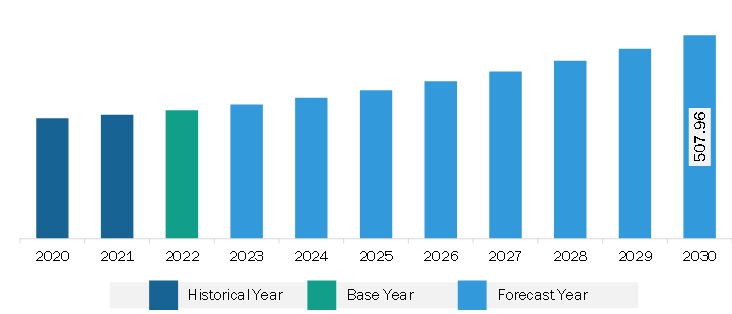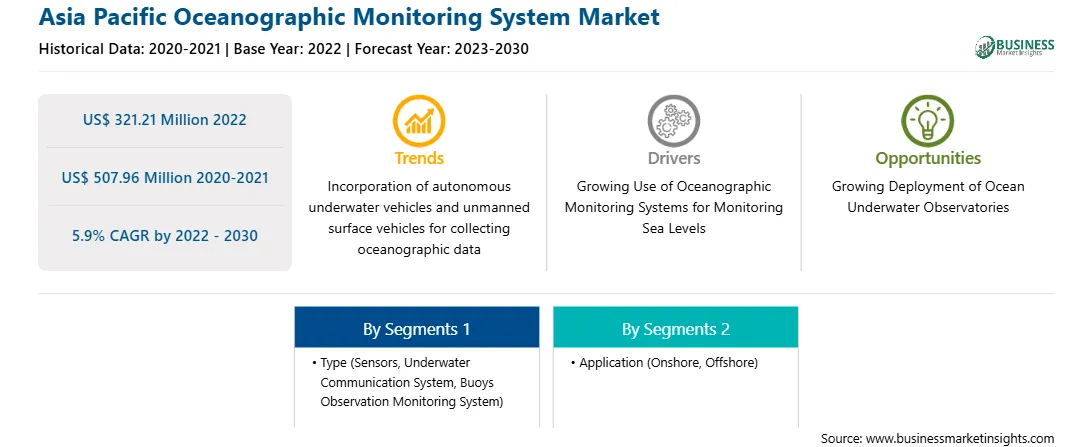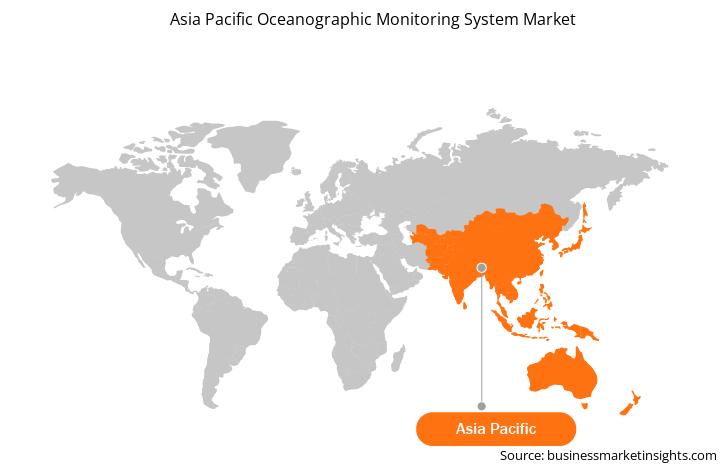The Asia Pacific oceanographic monitoring system market was valued at US$ 321.21 million in 2022 and is expected to reach US$ 507.96 million by 2030; it is estimated to record a CAGR of 5.9% from 2022 to 2030.
Oceanographic monitoring systems play an important part in environmental monitoring as they provide critical data on numerous aspects of the ocean's health. Ocean buoys, gliders, and profiling floats continuously monitor temperature and salinity at different depths. This data is used to detect ocean currents, comprehend global climate trends, and monitor the effects of climate change on the ocean's physical features. Also, monitoring sea level rise using tide gauges and satellite altimetry is critical for understanding the effects of melting glaciers and ocean thermal expansion. This information is vital for coastal towns facing a rise in sea levels, which leads to associated disasters such as floods and erosion. Moreover, there is a growing focus on comprehending and reducing the environmental impact of human activity in the ocean. investigate the effects of climate change and evaluate and monitor the health of marine environments. Thus, the growing demand for environmental monitoring is expected to create opportunities for the growth of the oceanographic monitoring system market during the forecast period.
The Asia Pacific oceanographic monitoring system market is segmented into Australia, China, India, Japan, South Korea, and the Rest of Asia Pacific. These countries have established several stations that collect data on oceanographic phenomena. For example, the Australian National Moorings Network (ANMN) consists of a number of National Reference Stations and regional mooring arrays. These oceanographic moorings collect data on currents, temperature, salinity, and other water quality characteristics at various depths. Australia Institute of Marine Science (AIMS) manages moorings on the Great Barrier Reef and across northern Australia. Further, AIMS manages and maintains two of Australia's seven National Reference Stations. The Q-IMOS Great Barrier Reef National Reference Station, situated near the wreck of the SS Yongala, and the IMOS Darwin National Reference Station collect long-term baseline data on ocean conditions that include currents, waves, weather, temperature, salinity, plankton, and water quality/biogeochemistry.
Moreover, India is developing and deploying various equipment to measure water pressure to detect tsunami waves. For example, in May 2023, Sonardyne updated a network of deep-water acoustic sensors that offers India's coastal communities an early warning of tsunami waves. The sensors are deployed at significant locations in the Arabian Sea and the Bay of Bengal; the network of Sonardyne's Bottom Pressure Recorders (BPRs) is maintained and operated by India's National Institute of Ocean Technology (NIOT) as part of the country's Tsunami Early Warning System (TEWS). The BPRs detect the distinctive changes in water pressure (as minute as 1cm in 4,000m depth) affected by an earthquake in the deep ocean. Thus, the rising development of such sensors creates demand for oceanographic monitoring systems.

Strategic insights for the Asia Pacific Oceanographic Monitoring System provides data-driven analysis of the industry landscape, including current trends, key players, and regional nuances. These insights offer actionable recommendations, enabling readers to differentiate themselves from competitors by identifying untapped segments or developing unique value propositions. Leveraging data analytics, these insights help industry players anticipate the market shifts, whether investors, manufacturers, or other stakeholders. A future-oriented perspective is essential, helping stakeholders anticipate market shifts and position themselves for long-term success in this dynamic region. Ultimately, effective strategic insights empower readers to make informed decisions that drive profitability and achieve their business objectives within the market.

| Report Attribute | Details |
|---|---|
| Market size in 2022 | US$ 321.21 Million |
| Market Size by 2030 | US$ 507.96 Million |
| Global CAGR (2022 - 2030) | 5.9% |
| Historical Data | 2020-2021 |
| Forecast period | 2023-2030 |
| Segments Covered |
By Type
|
| Regions and Countries Covered | Asia-Pacific
|
| Market leaders and key company profiles |
The geographic scope of the Asia Pacific Oceanographic Monitoring System refers to the specific areas in which a business operates and competes. Understanding local distinctions, such as diverse consumer preferences (e.g., demand for specific plug types or battery backup durations), varying economic conditions, and regulatory environments, is crucial for tailoring strategies to specific markets. Businesses can expand their reach by identifying underserved areas or adapting their offerings to meet local demands. A clear market focus allows for more effective resource allocation, targeted marketing campaigns, and better positioning against local competitors, ultimately driving growth in those targeted areas.

The Asia Pacific oceanographic monitoring system market is categorized into type, application, and country.
Based on type, the Asia Pacific oceanographic monitoring system market is categorized into sensors, underwater communication system, and buoys observation monitoring systems. The sensors segment held the largest market share in 2022.
In terms of application, the Asia Pacific oceanographic monitoring system market is bifurcated into onshore and offshore. The onshore segment held a larger market share in 2022.
By country, the Asia Pacific oceanographic monitoring system market is segmented into Australia, China, Japan, India, South Korea, and the Rest of Asia Pacific. China dominated the Asia Pacific oceanographic monitoring system market share in 2022.
GOST Global, Hitachi Zosen Corporation, Sonardyne, Xylem, Trelleborg Marine and Infrastructure, Sercel, MOBILIS, and Smart Buoy Co are some of the leading companies operating in the Asia Pacific oceanographic monitoring system market.
The Asia Pacific Oceanographic Monitoring System Market is valued at US$ 321.21 Million in 2022, it is projected to reach US$ 507.96 Million by 2030.
As per our report Asia Pacific Oceanographic Monitoring System Market, the market size is valued at US$ 321.21 Million in 2022, projecting it to reach US$ 507.96 Million by 2030. This translates to a CAGR of approximately 5.9% during the forecast period.
The Asia Pacific Oceanographic Monitoring System Market report typically cover these key segments-
The historic period, base year, and forecast period can vary slightly depending on the specific market research report. However, for the Asia Pacific Oceanographic Monitoring System Market report:
The Asia Pacific Oceanographic Monitoring System Market is populated by several key players, each contributing to its growth and innovation. Some of the major players include:
The Asia Pacific Oceanographic Monitoring System Market report is valuable for diverse stakeholders, including:
Essentially, anyone involved in or considering involvement in the Asia Pacific Oceanographic Monitoring System Market value chain can benefit from the information contained in a comprehensive market report.